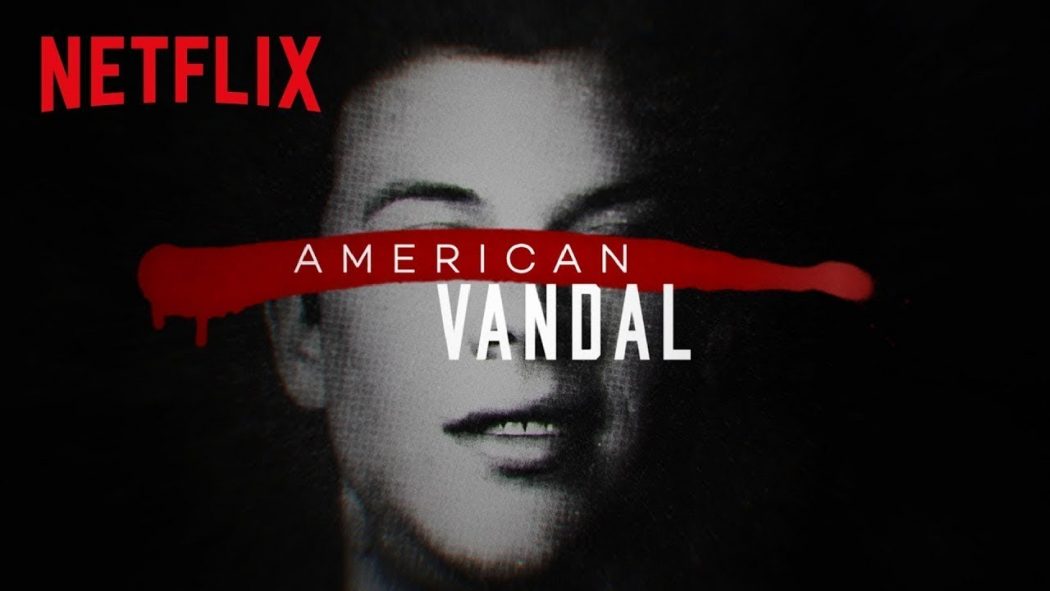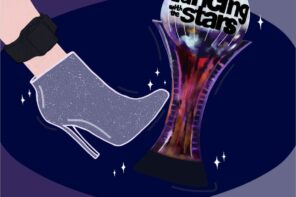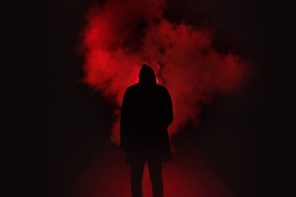There’s a compelling case to be made that Silicon Valley perfected the dick joke in its first season finale. It had it all: a perfect setup, plenty of diagrams, and way too much thought put into it. It’s ten minutes of ridiculous comedy, an absurd, unexpected trip into the twisted minds of the characters in the show. The bit works because it takes itself perfectly seriously, with just enough realism to make it seem plausible and more than enough hand gestures to make it jaw-droppingly funny.
Yet compared to American Vandal, the dick joke in Silicon Valley feels quaint. Instead of a ten-minute sequence, Vandal takes the dick joke and turns it into an eight – episode season, complete with plenty more 3-D dioramas, stupid high schoolers, and timed reenactments. But what’s more interesting is that it’s told through the lens of a true-crime documentary. And it works. The show is captivating. It’s nearly impossible to take your eyes off the screen as you crave the answer to the question the show asks over and over: Who drew the dicks?
Vandal tells the story of Dylan Maxwell, a senior at Hanover High School, after he is expelled for spray-painting penises on every car in the staff parking lot. Peter Maldonado, a sophomore (and proto – Sarah Koenig), launches an investigation into the incident to clear Maxwell’s name. Using his knowledge of film and justice to document every key revelation in the case, Maldonado’s investigation produces the documentary Vandal. At its heart, the show is an ode to amateur filmmaking, with a narrative that constantly returns to the students that drive the series. This goes all the way down to the opening titles, which list the characters names instead of the actors’, and even listing the “executive producer” as Mr. Baxter, the teacher who runs the school’s TV studio.
These callbacks to student filmmaking lend in part to one of the strongest parts of the series. Vandal works hard to establish realistic, likeable high school-aged characters, and that work pays off. The characters in the show don’t feel like young adult caricatures thrown into sixteen-year-old bodies, a much-needed reprieve from other Netflix originals such as Riverdale and Thirteen Reasons Why. The kids of Vandal feel like genuine high-schoolers, restricted by their age, environment and the perception of their peers.
“The characters in the show don’t feel like young adult caricatures thrown into sixteen-year-old bodies, a much-needed reprieve from other Netflix originals such as Riverdale and Thirteen Reasons Why.”
The high schoolers in Vandal are just that: they aren’t the smartest, or the most sexual, or the most mature, but just high schoolers. By avoiding making the characters of Vandal perfected versions of high school teens, Vandal builds a group of friends into one of the best depictions of modern life in high school in recent history.
In spite of its successes as a TV show, Vandal serves as an excellent case study into its genre. Vandal demonstrates the compelling power that true-crime shows have over audiences, pulling out all the tropes that series like Serial, Making a Murderer, and The Jinx first popularized. Many plot elements of Vandal are pulled directly from those shows, like Maldonado’s recreation of the crime, which plays out almost identically to Sarah Koenig retracing Adnan Syed’s steps in Serial to see if the crime was possible as described in court.
Vandal’s ability to completely capture the audience’s attention speaks to the perfect demand for attention carried by the true-crime genre. After all, Vandal is a show about a guy who ostensibly ran around a parking lot spray-painting penises—it’s far from a compelling story, at least on the splattered surface. But it seems that modern producers and television creators have all but perfected the art of building a captivating story out of a true-crime situation. The genre has been able to consistently capture audience imagination—think of the frenzy of fan theories and change.org petitions about Making a Murderer after it was released, or the influx of new evidence Koenig was able to use to investigate Syed’s story after fans started becoming a part of her story. Though fan theories are far from unique to the genre, true-crime is unique because rather than allowing the viewer to be a passive part of the story, it requires that the viewer partakes in the story.
“Though fan theories are far from unique to the genre, true-crime is unique from other genres because rather than allowing the viewer to be a passive part of the story, it requires that the viewer partakes in the story.”
Of course, nearly every genre wants the viewer to be an active part of their story. After all, part of the fun of enjoying a show is in speculating about where it will go next. After being with the same characters for hours and hours, there will almost certainly be a curiosity and active participation in the story. Yet as opposed to other genres, which earn viewers over time, the structure of the true-crime documentary series demands that attention from the start.
Serial built its popularity by asking every question it could possibly ask about the case of Adnan Syed. Making a Murderer asked the same questions about Steven Avery. Even The Jinx applied the same meticulous, intense investigation to the story of Robert Durst. These questions force the viewer to wonder about everything in the story from the very start. But despite their depth, each of these stories could be summarized into a single, all-encompassing question that serves as their basis. Did Adnan kill Hae? Why was Avery imprisoned? How did Durst do it? And, for American Vandal: “Who drew the dicks?”
The simplicity in this format–asking a basic question and spending hours figuring out the best way to answer it—is part of why true-crime series have gained so much traction. It’s part of why season two of Serial failed: it had no such question. Even Narcos built this format into their show, with the second series’ tagline being “Who killed Pablo?” But the true-crime genre works best at weaving such a pure core into its narrative, because that core is the narrative. The genre perfectly gives the opportunity to raise leads for the sake of generating a snowball of curiosity that always brings the series back to the central question. There are a constant stream of questions raised by various bits of evidence that build on, without distracting from, the core of the show.
“Did Adnan kill Hae? Why was Avery imprisoned? How did Durst do it? And, for American Vandal: “Who drew the dicks?”
Therefore, Vandal is successful as both a satire of the true-crime genre and as a true-crime series in and of itself. By identifying the moving parts that make true crime series work, American Vandal brings to light the inherent humor in how seriously we take true crime series like Serial. At the same time, by using those narrative pieces that make true-crime so successful, particularly the core question, Vandal functions on its own as an excellent “true crime” series. So even if it’s not as “real” as an honest-to-goodness true crime show, Vandal is just as addictive.
The constant search for answers—which are often only given at the end—is key to Vandal, Serial, and others like them. It’s also part of what makes Vandal such a perfect show for Netflix, where serving the next binge-worthy show is the goal. Based on the success of true crime series like Making a Murderer and Vandal—because of their format just as much as their content and plot—it’s likely that plenty of future shows on services like Netflix will follow a similar formula, where the questions raised by the show lend themselves perfectly to an urge to keep clicking on the next episode. At the end of the day, American Vandal is a blast to watch. It’s a piece of addictive, fun television that, while it may not be the most memorable, is certainly worth giving a shot. It also is a piece of the puzzle that is modern television: perfectly bingeable. So even if you thought you were happy with the ten minute dick joke in Silicon Valley, a four hour one is somehow just as successful, and, surprisingly, not a bad way to spend some time on Netflix.








